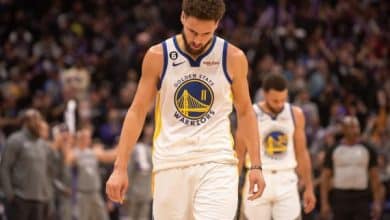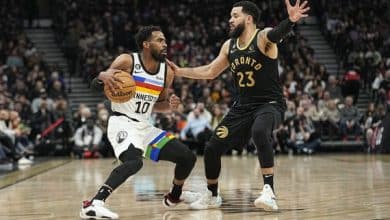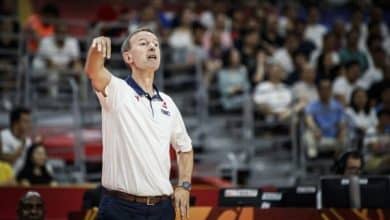
For his third left knee operation in 14 months, which “went well” according to the doctors, Lonzo Ball underwent an unusual procedure: a cartilage graft. For knee cartilage injuries, we have often been accustomed to cuts or sutures. The two methods offer different recovery times.
On the other hand, a knee cartilage transplant is unprecedented in the NBA. It is an intervention that Professor Matthieu Ollivier, of the Institute of Movement and Locomotor System (IML) in Marseille and one of the great French specialists in knee surgerypractical and knows very well. He is therefore perfectly placed to discuss the problems encountered by the Bulls playmaker.
As a reminder, cartilage is this protective layer of a few millimeters that covers the epiphyses of the bones. To put it simply, this is the “knee earthenware”he summarizes for us, before going into the details. “Cartilage is a structure that unfortunately does not grow back. It is one of the rare human tissues in this case. We can put stem cells or Lourdes water on it, nothing will happen… Why? Because 99% of it is cell-free. There are no cells, so it’s wishful thinking to think we can regrow it. Technically, it doesn’t work well. »
Once this statement has been made, the question that arises, faced with a player who has lost cartilage, is naturally always the same: how to add it to him? In the early 2010s, in the NBA, the phenomenon of “microfracture” became widespread. It was not a type of injury, but a type of intervention, better known in the medical community under the name of “microperforation”.
“There have been several developments in cartilage surgery”recalls the IML professor, before explaining this operation. “For a long time, we made small holes in the damaged area, thinking that it would grow back. We realized, about ten years ago, that it was not really effective. It’s not as fashionable as it used to be. »
What does a transplant consist of?
Above all, this procedure does not concern the most important lesions, those which involve several square centimeters of cartilage. When the injury is considerable, we can then go for a transplant. Notable precision: as the cartilage is an inert organ, there is no anti-rejection treatment to prescribe, as in the context of a liver or heart transplant for example.
If we arrive at this extreme solution, it is most often for players who have had other knee problems, especially the meniscus. The surgeon takes the example of Zion Williamson. “We removed the outer meniscus so he has a hole in the cartilage. Because removing the menisci from the knee is like removing the tires from a car and rolling on the rims. And rolling on the rims, in the long term, it makes holes. »
But this term transplant brings together a lot of things. To start, there is the autograft, or “mosaicplasty”, the main operation in the 2000s. The principle is simple: unscathed cartilage is taken between the femur and the patella to be placed between the femur and the tibia . An attempt is thus made to fill the holes in order to reproduce, if possible, the structure identically. It’s never perfect and that’s an obvious problem. “We undress Pierre to dress Paul”observes Matthieu Ollivier. “So the lesion must not be too significant. »
Second solution: xenograft. It is carried out with collagen “substitutes” (or “membranes”) which come from animals, mainly horses or oxen. But here too, the result is not always satisfactory either.
Finally, the last option, the allograft, with cartilage from a deceased donor, as can be done with conventional organs. The main complication? The conversation. Because in France, for lack of donors and because the cost is very high, we do not have a “fresh allograft”, ie less than 7 to 15 days old. “Frozen” grafting is therefore performed with a graft thus preserved in nitrogen vapor, at -180°C.
The last chance operation?
According to Matthieu Ollivier, Lonzo Ball’s first operation was a “microperforation” which failed. And an operation that does not give satisfaction is a risk that increases for the future. “It’s the problem of the screw in the placo: as soon as we remove the work that has been done but which did not work, we are always a little greedy with the healthy cartilage. So we aggravate the size of the hole. »

If you find yourself on the wrong side of the scale, around 30%, the level of performance decreases and the player can no longer hope to find the very high level. But only to no longer hurt. “We make an easy promise of comfort of life with an operation like that. But not a performance promise. »
Who says exceptional surgery, does he necessarily also say exceptional rehabilitation, perhaps longer? “It’s rescue, so the precautionary principle increases”he says, estimating that you have to wait between 9 and 10 months before playing again. “We are going to slow down the pace enormously compared to a simple meniscal suture. We’re going to do things slowly. In the first case, for me, it is support and resumption of sport at three months with a well-done suture and a satisfactory MRI. In the second, that of a transplant, it is no support before six weeks, and resumption of walking and running at four or five months. »
Lonzo Ball’s career at a very high level is therefore clearly in danger. Nevertheless, as we have seen with the percentages given by Matthieu Ollivier, everything is still possible. “These are players who have extraordinary recovery capacities”, continues the professor, who has already operated on basketball players. He slips the example of Stan Wawrinka, who underwent a cartilage transplant in the United States in 2017. The Swiss has certainly never found the heights as before, but at 38 (he will have them in two days), he is still on the ATP circuit and remains competitive.
A future solution?
Does this mean that this operation, when it works, is a miracle solution, which could revive formerly doomed careers? The fresh allograft is “the solution of the future for serious knee cartilage problems for players”assures the specialist, before qualifying. “Are we going to save knees? Yes. But careers? I don’t know… These are heavy operations for the players. It’s almost putting on a natural knee prosthesis. We often graft the femur and sometimes the tibia with it. A hole of three centimeters is then made in the knee, to put the cartilage of deceased person. »
Solution of the future therefore, but to handle with precaution. “If this operation fails, the next sanction is the prosthesis. We remove the knee to put metal in its place. And there, the cases of professional players, regardless of the sport, with a knee prosthesis, I don’t know of any. To make a career out of it, for the moment, is clearly no. For a hip prosthesis, there is Djibril Cissé, operated in my service, who played in Ligue 2. There, it is feasible. »
Matthieu Ollivier and other specialists have also signed an article in 2022 in the British Journal of Sports Medicine on this issue of prostheses. Everyone had the same question: is undergoing hip or knee arthroplasty really a possible way to relaunch a career?
“In the past, the answer would have been a clear and definite ‘no'”can we read in this article. “Patient-athletes would have been advised to stop their careers, give up their Olympic dreams, reduce their joint load to avoid or lessen their symptoms, and undergo non-operative treatment or opt for bone-sparing surgery. ‘joint. But in recent years, orthopedic surgery has evolved through greater recognition of patient autonomy and a shared decision-making approach. […] But is it a wise decision? So far, there is no evidence regarding the medium or long-term results of early arthroplasty in high performance athletes. »
Because a prosthesis, like the original organ it replaces, also deteriorates over time. And when it is no longer in good condition, what to do next? “Although the short-term results may seem encouraging in some sports, healthcare professionals should remain cautious before generalizing access to such procedures in young and active high-level athletes”, continues the article in which the IML professor participated. “The potential problems related to surface wear and loosening can be increased by sports practice and lead to early surgical revisions with an increased risk of associated surgical complications. »












